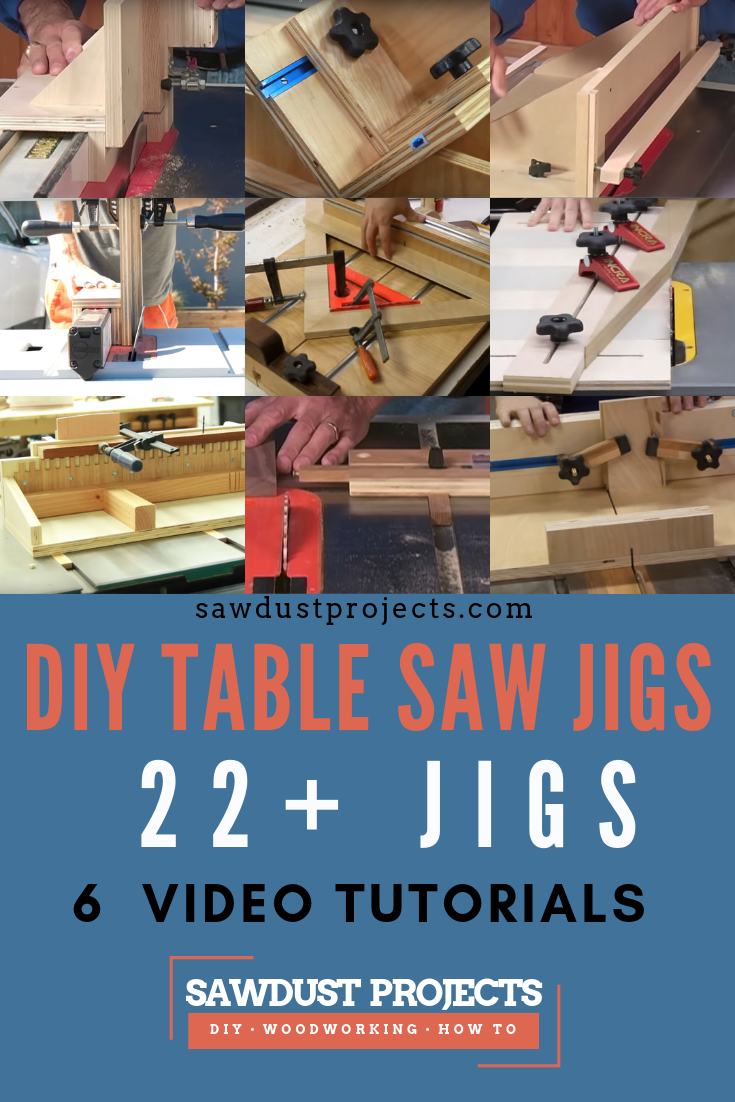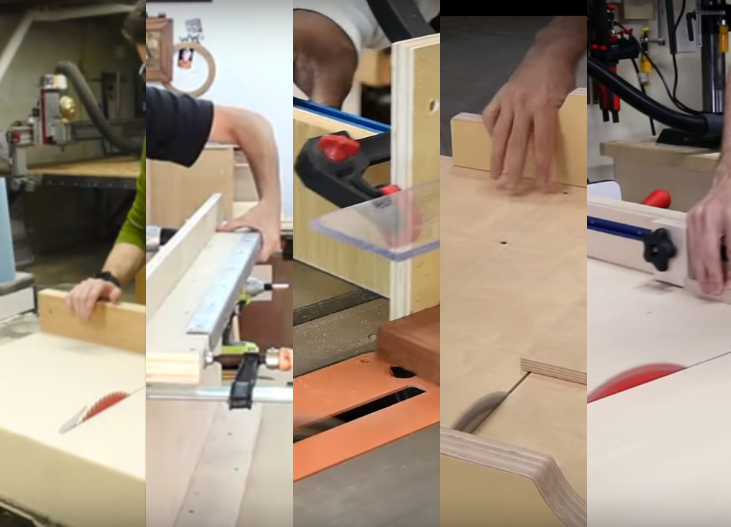
When thinking about using a table saw, some people might think that the type of cuts you can do with it would be limited. However, by building jigs to use in combination with your table saw, one can greatly expand the type of cuts and quality of projects that you can create with your table saw. The following are an assortment of great jig building tutorials to help you expand your repertoire of table saw skills as you tackle your upcoming DIY woodworking projects.
Shop Work: Ultimate Table Saw Jigs Part 1 | Fisher’s Shop
Table Saw Jig Video Summary:
Fisher does a great job of efficiently teaching you what he is building and explaining why he builds a certain way. I particularly liked all of the options available with the crosscut sled that he built which provides to attachments and jigs to be used with his crosscut sled.
Table Saw Jig Video Clips:
(0:30) – Thin strip table saw jig;
(4:21) – Crosscut sled;
(9:10) – Miter saw attachment to crosscut sled.
Unique Table Saw Jig Video Clips:
(7:20) – His method of adjusting the back fence after the 5-cut method measurement.
Shop Work: Ultimate Table Saw Jigs Part 2 | Fisher’s Shop
Tools Used In This Table Saw Jig Video:
Table Saw Jig Video Summary:
I like that fisher doesn’t take himself too seriously throughout the video, but he does an excellent job of breaking down the process of how to make these jigs. His video is efficient and well edited and he does a great play-by-play commentary on each step of the process.
Table Saw Jig Video Breakdown:
(0:33) – Tapering jig;
(4:12) – Spline jig ;
(8:44) – Box joint jig;
Top 10 Woodworking Table Saw Jigs and Accessories & How To Make Them – According to Me | Chris Salomone
Tools Used In This Table Saw Jig Video:
Table Saw Jig Video Summary:
This video really has only two or three table saw jigs that he actually builds. The other “jigs” that he recommends are ones that he purchased or are just accessories for a table saw. He could have made these table saw jigs himself, as that is what is implied by the term “jig” and he could have also done without the coffee commercial in the middle.
Table Saw Jig Video Clips:
(0:40) – Crosscut sled;
(6:53) – Rockler Crosscut sled;
(7:30) – Miter gauge;
(8:22) – Tapering Jig;
(9:52) – Vertical panel jig (Tenoning jig);
(14:36) – Zero clearance insert plate;
(15:30) – Feather-board;
(16:05) – Push stick.
Tool Talk #13: All of my table saw sleds and jigs | Jay Bates 2 – Vlog and Non Project Videos
Table Saw Jig Video Summary:
Jay does a good job explaining that some jigs are great, but he starts out with the jigs that didn’t work out as great as he thought they would, and then gradually moved to the jigs that he likes and uses more and more. I also like this video because he explains how he made the jig simple and easy to use, like with his jointer jig, he chose not to use t trak, but his design still accomplishes the same ends.
Table Saw Jig Video Clips:
(0:49) – Dedicated 45 degree crosscut sled;
(1:27) – Miter sled;
(2:52) – Spline jig that attaches to a miter gauge;
(5:21) – Single blade single pin box joint jig;
(7:21) – Plywood jig, the hold down jig, jointing jig, without a runner;
(9:30) – Two sided crosscut sled;
(11:06) – One sided crosscut sled.
Unique Table Saw Jig Video Clips:
(2:52) – Jay goes into terrific detail for the reasons why one would use a spline jig and how it can be useful.
(11:06) – This was the first encounterIV’ve had with a single sided cross cut sled, and he explains why this version of the crosscut sled is so useful.
Dovetail Jig for the Table Saw // Woodworking Joinery | 3x3Custom – Tamar
Tools Used In This Table Saw Jig Video:
Table Saw Jig Video Summary:
A dovetail table saw jig is not a jig you come across very often. Tamara did a great job of explaining all parts of the process, from marking, cutting, layout, and assembly, as well as what you need to think about when attempting to use this type of table saw jig.
Table Saw Jig Video Clips:
(0:36) – Cutting, labeling, and glueing jig pieces;
(3:03) – Marking layout and assembly;
(3:47) – Runners;
(4:52) – Pin and tail jig assembly;
(6:05) – Blade guards;
(6:38) – Jig use and layout line explanation and example for pin pieces ;
(8:59) – Example of cutting and how to use the jig to make the dovetail pin pieces;
(11:29) – Example of how layout and to cut the tail of the dove tail
(15:46) – Tailpiece clean up of waste;
(20:04) – Joining the dovetail pieces, and afterthoughts of building the jig.
Unique Table Saw Jig Video Clips:
(3:03) – I really liked how she explained how she planned the layout of the jig so that brad nails weren’t put in the wrong place during assembly.
(6:38) – Her layout of the dovetail pieces and how high to set the blade was fantastic and will be very helpful when actually trying to use this table saw jig.
12 Great Tablesaw Jigs with Jim Heavey – WOOD Magazine
Tools Used in this Table Saw Jig Video:
Table Saw Jig Video Summary:
This video is not a how to video. It’s more of an options video, where he shows you a bunch of different options of jigs that you could make and the general layout for each jig. This is a great video to learn the purpose of each one but not how to actually build them and the tips necessary to do so.
Table Saw Jig Video Breakdown:
(0:28) – Table set up and adjustment of blade, fence, and miter gage
(1:52) – Types of wood he uses for the jigs and why;
(3:30) – Zero clearance insert;
(6:38) – Miter gauge extension and precision stop;
(8:20) – Auxiliary rip fence;
(10:30) – 3-in1 work support;
(13:00) – Raised panel jig;
(16:30) – 90 degree cross-cut sled;
(20:50) – Four-sided tapering jig/jo;
(28:27) – Jointer jig;
(29:30) – Tenoning jigs;
(34:33) – Spline-cutting jig;
(37:00) – Thin-strip ripping jig;
(40:37) – Cove-cutting jig.
Table Saw Jig Video Unique Clips:
(3:30) – High grade plywoods and hardwood may chip if you use the factory clearance insert;
(8:20) – He gave some great reasoning for the auxiliary rip fence, and why you want to protect the existing rip fence ;
(29:44) – He talks about the ⅓ rule for mortise and tenon.


